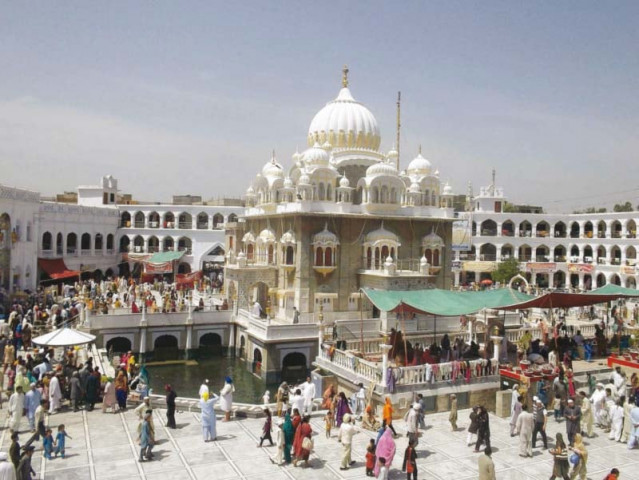Happy Baisakhi
This year Sikhs will celebrate the Baisakhi festival at Gurdwara Punja Sahib in Hassanabdal amid strict security

Sikh pilgrims gathered around Gurdwara Sri Punja Sahib in Hassanabdal. PHOTOS : RASHID ALI

Sikh pilgrims being served karah prasad (pudding made from butter, sugar and flour). PHOTOS : RASHID ALI
According to Sikh tradition, Guru Nanak, the founder of Sikh religion, came to Hassanabdal for the first time in the month of Vaisakh (April/May) along with Bhai Mardanaji and stayed under a tree at Gurdwara Punja Sahib. On the front of the hillside there is a meditation chamber related to the 15th century Muslim saint, Baba Wali Kandhari. It houses the imprint of the hand or punja believed to be that of Guru Nanak. This is the only reason why this gurdwara is known as Punja Sahib.
The festival is celebrated with a great deal of feasting, bhangra, folk music and fairs. Locals dress up in their finest clothes and sing and dance to folk music. There are also races, wrestling bouts and acrobatics. In the morning, Sikhs visit the gurdwara to attend special prayers. Most Sikhs strive to visit the revered Golden Temple in Amritsar or Anandpur Sahib. Of all the rituals involved in Baisakhi, the ritual of Bhog (literally ‘delight’) is the most significant, in which the Guru Granth Sahib, the holy book of Sikhs, is bathed with milk and water, placed on a throne and read out to followers. At noon, the karah prasad (pudding made from butter, sugar and flour), is offered to the guru for his blessings. It is then distributed among members of the congregation. The ceremony culminates with a special guru ka langar or a community lunch. People sit in rows with their heads covered as volunteers serve them a vegetarian meal.

Sikh pilgrims taking a bath in the holy water of the gurdwara. PHOTOS : RASHID ALI
Owing to the recent attacks on places of worship in the country, strict security measures have been taken to protect the pilgrims this year. This includes the deployment of over 1,600 police officials, four deputy superintendents, six inspectors, 11 sub-inspectors, 23 assistant sub-inspectors, 33 head constables, 606 constables, 12 lady constables and over 100 officials in different areas around the temple. Additionally, teams of Rescue 1122 will also be positioned at the event to provide medical care to pilgrims. For entrance into the gurdwara, special security passes have also been arranged.

A Sikh granthi (priest) reciting the holy Granth Sahib. PHOTOS : RASHID ALI
Furthermore, in order to facilitate the Sikh yatris within the vicinity of Punja Sahib, money exchangers, banks, religious stalls and easy load facilities will also be made available.
Rashid Ali is a correspondent at Daily Express, Sanjwal Cantt and tweets @hasniattock
Published in The Express Tribune, Sunday Magazine, April 12th, 2015.












1726134115-0/BeFunk_-(41)1726134115-0-208x130.webp)






COMMENTS
Comments are moderated and generally will be posted if they are on-topic and not abusive.
For more information, please see our Comments FAQ